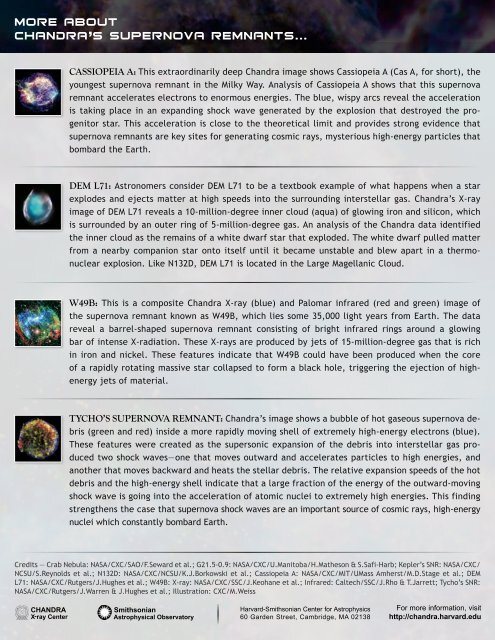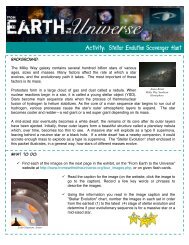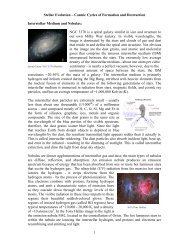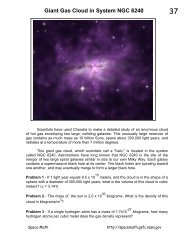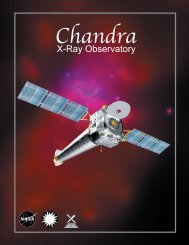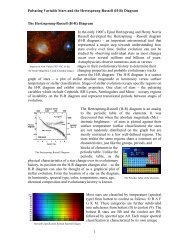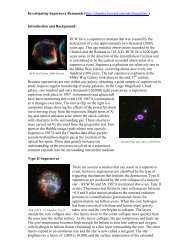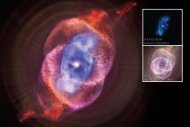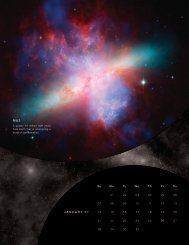Supernova Remnants - Chandra X-ray Observatory
Supernova Remnants - Chandra X-ray Observatory
Supernova Remnants - Chandra X-ray Observatory
You also want an ePaper? Increase the reach of your titles
YUMPU automatically turns print PDFs into web optimized ePapers that Google loves.
More about<br />
<strong>Chandra</strong>’s <strong>Supernova</strong> <strong>Remnants</strong>...<br />
Cassiopeia a: This extraordinarily deep <strong>Chandra</strong> image shows Cassiopeia a (Cas a, for short), the<br />
youngest supernova remnant in the Milky Way. analysis of Cassiopeia a shows that this supernova<br />
remnant accelerates electrons to enormous energies. The blue, wispy arcs reveal the acceleration<br />
is taking place in an expanding shock wave generated by the explosion that destroyed the progenitor<br />
star. This acceleration is close to the theoretical limit and provides strong evidence that<br />
supernova remnants are key sites for generating cosmic <strong>ray</strong>s, mysterious high-energy particles that<br />
bombard the earth.<br />
Credits — Crab Nebula: NASA/CXC/SAO/F.Seward et al.; G21.5-0.9: NASA/CXC/U.Manitoba/H.Matheson & S.Safi-Harb; Kepler’s SNR: NASA/CXC/<br />
NCSU/S.Reynolds et al.; N132D: NASA/CXC/NCSU/K.J.Borkowski et al.; Cassiopeia A: NASA/CXC/MIT/UMass Amherst/M.D.Stage et al.; DEM<br />
L71: NASA/CXC/Rutgers/J.Hughes et al.; W49B: X-<strong>ray</strong>: NASA/CXC/SSC/J.Keohane et al.; Infrared: Caltech/SSC/J.Rho & T.Jarrett; Tycho’s SNR:<br />
NASA/CXC/Rutgers/J.Warren & J.Hughes et al.; Illustration: CXC/M.Weiss<br />
ChAndrA<br />
X-<strong>ray</strong> Center<br />
Dem l71: astronomers consider deM L71 to be a textbook example of what happens when a star<br />
explodes and ejects matter at high speeds into the surrounding interstellar gas. <strong>Chandra</strong>’s X-<strong>ray</strong><br />
image of deM L71 reveals a 10-million-degree inner cloud (aqua) of glowing iron and silicon, which<br />
is surrounded by an outer ring of 5-million-degree gas. an analysis of the <strong>Chandra</strong> data identified<br />
the inner cloud as the remains of a white dwarf star that exploded. The white dwarf pulled matter<br />
from a nearby companion star onto itself until it became unstable and blew apart in a thermonuclear<br />
explosion. Like n132d, deM L71 is located in the Large Magellanic Cloud.<br />
W49b: This is a composite <strong>Chandra</strong> X-<strong>ray</strong> (blue) and palomar infrared (red and green) image of<br />
the supernova remnant known as W49b, which lies some 35,000 light years from earth. The data<br />
reveal a barrel-shaped supernova remnant consisting of bright infrared rings around a glowing<br />
bar of intense X-radiation. These X-<strong>ray</strong>s are produced by jets of 15-million-degree gas that is rich<br />
in iron and nickel. These features indicate that W49b could have been produced when the core<br />
of a rapidly rotating massive star collapsed to form a black hole, triggering the ejection of highenergy<br />
jets of material.<br />
tyCho’s superNova remNaNt: <strong>Chandra</strong>’s image shows a bubble of hot gaseous supernova debris<br />
(green and red) inside a more rapidly moving shell of extremely high-energy electrons (blue).<br />
These features were created as the supersonic expansion of the debris into interstellar gas produced<br />
two shock waves—one that moves outward and accelerates particles to high energies, and<br />
another that moves backward and heats the stellar debris. The relative expansion speeds of the hot<br />
debris and the high-energy shell indicate that a large fraction of the energy of the outward-moving<br />
shock wave is going into the acceleration of atomic nuclei to extremely high energies. This finding<br />
strengthens the case that supernova shock waves are an important source of cosmic <strong>ray</strong>s, high-energy<br />
nuclei which constantly bombard earth.<br />
Smithsonian<br />
Astrophysical <strong>Observatory</strong><br />
Harvard-Smithsonian Center for Astrophysics<br />
60 Garden Street, Cambridge, MA 02138<br />
For more information, visit<br />
http://chandra.harvard.edu


